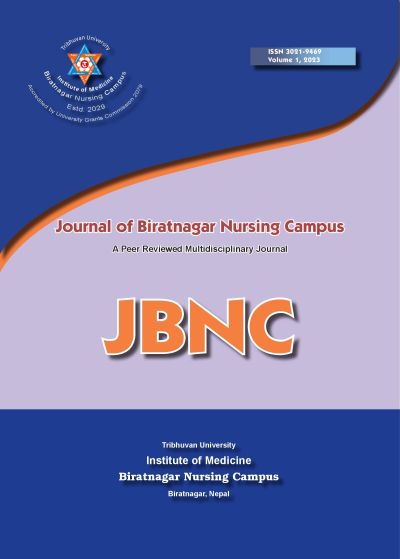Behavioral Risk Factors of Non-Communicable Diseases among Pregnant Women Attending Health Centers of Morang Nepal
DOI:
https://doi.org/10.3126/jbnc.v1i1.63254Keywords:
Non-communicable Disease, Risk factors, Pregnant women, Health CentreAbstract
Background: Obstetric transition, where patterns of maternal mortality due to indirect causes, such as NCDs, are replacing patterns of maternal mortality due to direct causes, including hemorrhage and infection. The change in the social determinants has affected the behavioral and metabolic risk factors of NCDs. Thus the aim of this study is to assess the behavioral risk factors of non-communicable diseases among pregnant mothers attending health centers in Morang Nepal
Methodology: A cross-sectional study was conducted to assess the behavioral risk factors among 250 pregnant women attending health services in Morang district in 2022. Face-to-face interviews were done to gather data using the WHO NCDs STEPS survey questionnaire version 3.2 from two hospitals and 1 PHC and 100 pregnant women from each hospital and 50 pregnant women from taken PHC consecutively. Descriptive statistics like mean, proportion, and standard deviation were used to assess the prevalence of NCD risk factors. Likewise, total physical activity is categorized as respondents meeting WHO recommendations and not.
Results: The mean and standard deviation of respondents’ age was 24.70±4.18. In dietary habits, 38.8% of respondents sometimes add salt to their food right before they eat, and 70% of respondents sometimes eat processed food high in salt. More than half (58.8%) of respondents did not meet the physical activity recommendations of WHO and more than half (56.8%) of the respondents received advice to eat at least five servings of fruit and/or vegetables from doctors and healthcare workers.
Conclusion: The study concludes that high amounts of salt consumption and insufficient physical activity are the behavioral risk factors of NCDs among pregnant mothers.
Downloads
Downloads
Published
How to Cite
Issue
Section
License
Copyright (c) 2023 Biratnagar Nursing Campus

This work is licensed under a Creative Commons Attribution 4.0 International License.
This license enables reusers to distribute, remix, adapt, and build upon the material in any medium or format, so long as attribution is given to the creator. The license allows for commercial use. If you remix, adapt, or build upon the material, you must license the modified material under identical terms.




